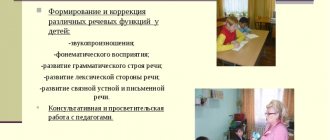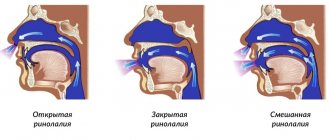OHP in speech therapy stands for general speech underdevelopment. The issues of classification of communication defects of this group were dealt with by R. E. Levina, T. B. Filicheva, L. F. Spirova. Research and analysis of the results obtained were carried out in the 50-60s of the 20th century. The joint work of professional speech therapists and teachers made it possible to identify 4 levels of OHP: I, II, III are presented in the works of R. E. Levina, and IV is described in the book by T. B. Filicheva “Features of speech formation in preschool children.”
Description
OHP level IV refers to a mild type of speech underdevelopment in preschoolers. The defect may go unnoticed if the child’s speech is not listened to by a professional speech therapist or teacher. The speech of a preschooler is understandable, but is characterized by an erratic pace, incoherence when composing stories, mixing a small number of sounds, and skipping syllables in complex words. But even such minor gaps in articulatory and communicative development can cause failure at school and difficulties in mastering the curriculum.
Recommendations
The experience accumulated by speech therapists indicates that it is necessary to improve speech development; for this, children require motivation. Despite the fact that lexical and grammatical errors are unimportant, the child subsequently experiences difficulties with the learning process. Compared to his peers, he remembers new material less well and does not master grammatical rules. To get rid of isolation and shyness, the child is immersed in social situations through games. Their complexity increases gradually, individually for each patient.
Causes
A thorough analysis of the speech skills of children with stage 4 ODD allowed T. B. Filicheva to talk about the possible causes of communicative underdevelopment. The professor of speech therapy sciences believes that the slow pace of speech formation in most cases is due to the following negative factors:
- birth injury;
- long-term somatic diseases in early childhood (hospitalism syndrome);
- unfavorable speech environment;
- communication deficit;
- bilingualism;
- psychological trauma.
At the same time, preschoolers with level IV OHP do not experience disturbances in the functioning of the central nervous system, hearing, or vision. It is also noteworthy that speech dysfunctions respond well to treatment and correction.
Causes of level IV OHP
There are 2 groups of factors that can lead to the 4th level of speech development - biological and social.
Biological include organic causes. These include features of the development of the central nervous system and speech organs. The acquisition of speech skills is influenced by the intrauterine development of the fetus. Bad habits of a pregnant woman, stress, placental insufficiency, toxicosis, intrauterine infections, fetal asphyxia and hypoxia, complicated labor (difficult, rapid, protracted) - all this affects the development of the baby after birth.
The events of the first year of a baby’s life are also of great importance: poor health, previous neuroinfections, post-vaccination complications, traumatic brain injuries - these are the main reasons for the general underdevelopment of level 4 speech. At risk are infants who began to walk late, babble, said their first word, or mastered phrasal speech - this indicates a possible delay in speech development.
Social are environmental factors. This includes the child’s speech environment, attitude towards him, and upbringing. It’s bad if parents don’t work with their child, don’t talk to him, don’t play. But no less harm is done to him by relatives who lisp, use diminutive or “childish” words (“bibi”, “kaka”, “little red”, “plate”). All this only makes it more difficult to master your native language. Bilingual children whose families speak two languages or “surzhik” are also at risk.
An unfavorable family situation, emotional stress or rejection, lack of communication and lack of contact with parents can also cause level 4 OHP.
Symptoms
All levels of general speech underdevelopment according to Levina and Filicheva are characterized by individual and general symptoms. In children with IV degree of speech underdevelopment, the following signs of articulation defect are observed:
- Lack of differentiation of sounds [р]-[рь], [л]-[л], [ш]-[ч], [ть]-[ц], [с]-[сь];
- Elysia - a reduction in the number of sounds in words (veloped - bicycle, boat - boat), less often the omission of entire syllables;
- Paraphrase is a violation of the rate of speech. Children miss words in sentences, speak quickly and indistinctly. A large text of 10 sentences is reduced to 2-4 when retelling;
- Perseveration - repetition of one syllable in a word several times (library library);
- Confusion of generic and species concepts (instead of the names of individual birds, the general word “bird” is used);
- Mixing of signs. Old = adult, long = big;
- Difficulties in word formation. This is mainly the use of diminutive suffixes in nouns and adjectives (raisin-raisin, coat-coat, volkin-wolf);
- Slightly limited vocabulary. Children try to use familiar units of speech in order to avoid lexical and grammatical errors;
- Difficulties in understanding abstract concepts, words with a figurative meaning, the semantic load of proverbs;
- Violations may be intermittent. If children are asked to choose only the correct one from two options, the task is usually completed correctly;
- Omissions or replacement of conjunctions in sentences (I ran where the puppy was sitting - where the puppy was sitting; they told me I didn’t touch the hot kettle - so that I didn’t touch the hot kettle);
- Inversions;
- When composing a story, they use uninformative, simple sentences;
- When describing a picture, preschoolers have difficulty identifying the main and the secondary, logically “get stuck” on details that are insignificant for the story, and repeatedly repeat one or two episodes;
- In coherent speech and when performing speech therapist tasks, it is difficult for children to select different root synonyms. Preschoolers prefer to use the prefix non- (big - small, beautiful - ugly).
Level 4 OSD is considered a minor type of speech disorder compared to other disorders. Gaps in development are not clearly expressed and are eliminated in a short period of time. But if a child does not receive the help of a speech pathologist, speech impairment will affect his intellectual growth and performance at school.
OHP level 4: characteristics of the violation
Initially, it was accepted to divide OHP into 3 groups - from 1st to 3rd. However, in 2001, professor, speech therapist-defectologist Filicheva T.B. included in the classification one more degree of OHP - the fourth.
In general, a child of the fourth level of OHP type speaks correctly, but still some errors and difficulties occur. Here are its signs:
- Children speak insufficiently clearly and expressively, articulation is “lame”;
- Difficulties are caused by the separation of sibilants, vibrants, that is, trembling consonants, and affricates (“ch” = “t” + “sch”, “ts” = “t” + “s”);
- They can replace or rearrange sounds, skip syllables. For example, instead of the word “hammer” say “skein”. But to a greater extent this applies to words with a complex syllabic structure and sound fullness;
- They do not sufficiently understand the meanings of words that denote the characteristics of objects. For example, they may say “the boy is long” instead of “the boy is tall”;
- They incorrectly form new words using suffixes. For example, instead of “dress” they will say “dress”;
- They make mistakes when agreeing nouns with adjectives (for example, “I am writing with a red pen”), they incorrectly use nouns in the plural genitive or nominative cases (for example, “I saw a lot of birds and animals at the zoo”);
- Do not understand the meaning of words that are not used in everyday life;
- Proverbs are interpreted incorrectly, antonyms and synonyms are selected;
- When retelling or composing a story, children confuse the sequence of events, cannot identify the main and secondary lines in the plot, and repeat the same thing.
The listed errors do not always occur. Deviations are so subtle that they can only be identified purposefully during an examination by a speech pathologist. But this must be done so that the first grader does not have learning difficulties in the future.
Characteristics of children with OHP type 4
Children have a good vocabulary, although it mainly consists of words of general use. Therefore, the meaning of rare words is usually unknown to them.
They have coherent speech, although somewhat blurred and unclear. They answer questions in detail and express their thoughts. But the speech is peculiar. If you ask a child to retell a story, he will focus on unimportant details and miss important ones; and when narrating on a free topic, he will choose simple words and simple sentences.
There is criticality to speech, that is, the child can understand that he made a mistake. If you offer him 2 options, he will choose the right one.
Children with OHP type 4 have good sounds and pronounce them correctly. But they lack clarity, so they need to work on articulation.
Kids skip or replace conjunctions. For example, they can say: “Dad said I was going home” (the conjunction “to” is missing), “I ran where the cat was sitting” (“where” instead of “where”).
Inversion occurs in sentences. For example, a preschooler with level 4 OHP will say: “We saw a kitten that we’ve been looking for for a long time” instead of “We saw a kitten that we’ve been looking for for a long time.”
Children with level 4 OHP also have the following characteristic: it is still difficult for them to plan their narrative.
Level 4 speech development is rarely diagnosed as an independent diagnosis. As a rule, children come to it after correctional work with a speech pathologist-speech pathologist, who were previously diagnosed with grade 3 ODD. The main characteristic of children with level 4 SLD is almost complete compliance with the age norm for speech development and readiness for school. A little more correctional work - and the children will completely overcome all barriers and easily begin to learn to write and read.
Diagnostics
To make a diagnosis, teachers and speech therapists require: a description of the preschooler from the preschool teacher and practical interaction with the child. At PMPK meetings, a certain set of exercises and tasks is used, which helps to identify ONR quickly:
- Conversation with a preschooler. The child answers questions about his place of residence, says his name, how old he is, who he came with, and so on.
- Compiling a story from pictures.
- Completing simple tasks to identify the level of development of thinking, logic, intelligence: remove the unnecessary and explain your choice, count what is drawn incorrectly in the picture, say something sweet, choose a synonym-antonym, etc.
- Motor skills examination. The child traces the picture along the dotted lines, draws straight and curved lines.
- During a conversation with a preschooler, the syllable structure of speech and the level of literacy development are assessed.
In addition to a direct examination of a preschooler, diagnosing level 4 OHP will require a therapist’s conclusions about the child’s general somatic health, collecting information about the mother’s pregnancy and childbirth, and conclusions from a child psychologist and neurologist.
Corrective program for level IV OPD
The optimal age for starting speech correction in children with ODD level 4 is 6 years. By the time a speech therapist enters school, he will have time to correct speech skills and prepare the future student for learning to write and read in first grade. These are the goals that correctional work pursues.
Classes are designed in such a way as to develop all language components.
Firstly , bring phonemic processes and sound pronunciation to a new level. First, the speech therapist works on articulation, then teaches how to distinguish sounds by ear and pronounce them based on acoustics and articulation. Particular attention is paid during classes to words with a complex syllable structure and consonant clusters, as well as sound-letter analysis. This will come in handy later when learning to read. Classes include speech therapy massage and articulation exercises.
Secondly , expand your vocabulary. It is important to fill the dictionary with new commonly used words and those that are used less frequently. The speech therapist teaches you to select homonyms, synonyms, antonyms, and create new words using prefixes and suffixes. Explains to students the meaning of sayings and proverbs, the figurative meaning of words.
Thirdly , to form the grammatical structure of the language. Attention is paid to gender, numbers, and cases. Children are taught to understand intonation and use it to identify interrogative and declarative sentences. They learn to ask questions correctly and answer them in detail, and learn prepositions.
Fourth , improve coherent oral speech. Children learn to construct and use complex sentences in everyday communication. During lessons, they retell or compose stories from pictures - they learn to fully reveal the topic, isolate the main and secondary points, use direct speech, and speak expressively and clearly.
Fifthly , prepare preschoolers to learn writing and reading. This is necessary to consolidate oral speech skills. The main goal is to prepare the hand for writing, introduce them to letters, and teach them to form words from them. During lessons, children work with the split alphabet.
Characteristics of the child
For level 4 OHP, a profile for the child is drawn up by a speech therapist or kindergarten teacher. The document is necessary for parents to pass the PMPK before entering the 1st grade of a special school or speech therapy group of a preschool educational institution.
To draw up a profile for a child, you can use the following plan:
- Full name of the preschool educational institution student, year of birth, parents’ passport details.
- Level of physical development (health group, level of motor development, dominant hand).
- Psychological characteristics of a preschooler (behavior in a preschool educational institution, in the classroom, features of interaction with children and teachers).
- Dictionary volume.
- Formation of the syllabic structure of speech.
- Level of auditory differentiation.
- Voice volume.
- Features of coherent speech.
- Positive aspects of a child's personality.
In addition to the listed points, the teacher can briefly add those points that he considers important for drawing up an objective picture of the preschooler’s health status.
Speech therapist Olga Bazhina, an expert on our website, has prepared a psychological and pedagogical description of children with general speech underdevelopment:
Psychological and pedagogical characteristics of children with special needs development
Discrimination from similar conditions
Speech disorders are accompanied by disorders of non-speech mental functions and motor skills (general, manual, articulatory). It is difficult for such children to concentrate on educational and didactic material. Behavioral deviations, hyperactive manifestations, and disturbances in the functioning of the autonomic nervous system are also observed.
At first glance, speech in children with ODD is similar to speech in other speech therapy disorders. During the examination, it is important to correctly diagnose similar conditions. The distinctive symptoms of FFNR and ONR are presented in the table.
The diagnostic results are entered into the speech card. The dynamics of correctional work are also noted there.







